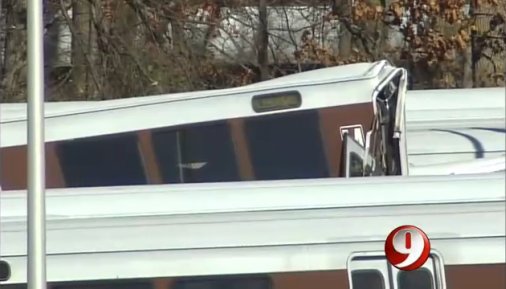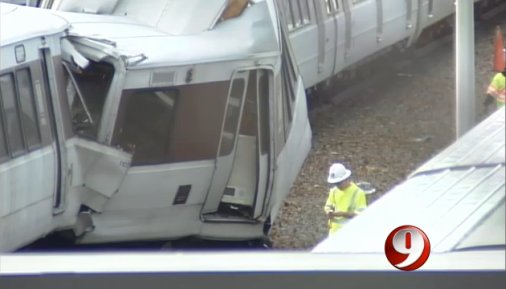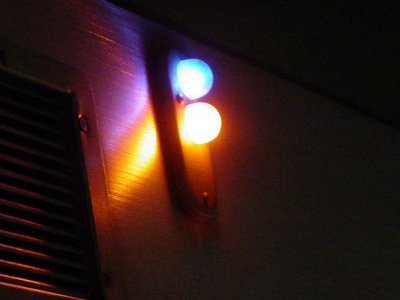You know, I didn’t expect the “bellying” of the 1000-Series cars to be proven to be window dressing so soon…
5 minute read
December 4, 2009, 8:27 PM
You may recall that after the June 22, 2009 collision on the Red Line, where Rohr 1079 telescoped on impact, Metro decided to sandwich the Rohr cars in between cars of other series in order to allegedly protect them in the event of a future collision, which Metro called “bellying”. The idea was that in a collision, the newer rail cars, allegedly of stronger construction than the Rohrs, would take the force of impact and leave the Rohrs unharmed.
I said at the time that if Metro was going to put the 1000-Series cars in the center of consists, they should do the same for the 4000-Series cars as well, since the first telescoping incident in 1996 involved Breda cars. Others derided Metro’s decision to put the Rohr cars in the center of consists, calling it a public relations move to make the public feel safer, but providing no real safety advantage. After thinking about it, I tended to agree. Seems that the critics were proven right, though I think that everyone involved, from Catoe and right down the line at Metro, as well as the riding public, had hoped never to find out if the idea was a good one or a bad one.
In the wee hours of Sunday, November 29, Metro had its second collision of 2009 at the Falls Church Yard off the K Route (Orange Line) in Fairfax County, Virginia. What happened is that train 902, which was the final Orange Line train of the night, was returning to the yard, and getting into position to be cleaned by yard workers. As it was approaching its final position, it managed to collide with the train ahead of it. There were no fatalities, but two yard workers and the operator of train 902 went to the hospital, and were treated and released. Three cars were believed to be damaged beyond repair, though all twelve cars involved sustained at least some damage.
The cars involved, according to Metro, were 1000, 3000, and 5000-Series cars. On the struck train, the arrangement was 5138-5139-1107-1106-3216-3217. On train 902, the arrangement was 5056-5057-1171-1170-3223-3222. In the collision, CAF 5056 struck Breda 3217. Of the cars involved, Metro believes 1106, 1171, and 3216 sustained damage beyond repair.
Note that two of the cars start with a “1”. That means Rohrs. And also note that this was not a single pair that was noted beyond repair. It’s one car in each consist. And additionally, these cars were in the center of their respective consists, as Metro wanted them to be for their own safety. And this is what happened:

Photo: WUSA

Photo: WUSA
(And no, I don’t know which is which.)
As you can see, one mid-consist Rohr telescoped in the usual way, and the other buckled sideways. And this was in a relatively low-speed collision. The speed limit in WMATA rail yards is 15 mph. However, one still has to realize that even at 15 mph, when you have a few hundred tons of train in motion, that translates into a lot of energy being transmitted to the receiving train. And with trains only being as strong as their weakest link, that energy found an outlet in those Rohr cars, as they absorbed that impact and crushed. I’m just glad that these trains were not in revenue service. If this had happened in revenue service, where the trains move a lot faster, there would probably have been many deaths.
So this seems to prove a few things. First, when on the striking end of things, the 5000-Series cars appear to be hardy enough to withstand a collision fairly well. None of the 5000-Series cars were immediately listed as beyond repair. Secondly, the rationale for placement of the Rohr cars in the middle of train sets, allegedly to provide added safety, proved to be false. The allegedly stronger cars just transmitted the energy back to the weaker ones. This gives me the impression that the Rohr cars are unsafe at any speed, regardless of where they are placed in a train consist. One of the main reasons, though, is that these cars are more than thirty years old, and are very much ready to be put out to pasture. Some 1000-Series cars even have stress cracks, which makes for a weaker carbody.
Now there is one thing worth noting, though, when comparing this to the June 22 collision. The June 22 collision happened on a revenue run on the mainline, where there is an Automatic Train Protection (ATP) system that is supposed to maintain safe speeds and proper spacing between trains. ATP does not exist in the yards, though trains are restricted to a 15 mph top speed. Because of ATP, I do not believe that the November collision could have occurred on the mainline with a working ATP system.
One thing I’ve read is that the 5000-Series car on the striking car allegedly “surged”, which caused the collision rather than the intended stop. I’m not sure if I’m thinking of the same thing they’re talking about, but I’ve seen some odd behaviors twice on trains where 5000s were in the lead. One was on February 15, 2006 at Anacostia, with CAF 5159 in the lead. In that case, when the car made the station stop at Anacostia, the doors started to open, and then the car started to take off. The doors slammed shut, and then the car quickly stopped again, and serviced the station normally. In discussion with the operator of that train at Branch Avenue, I found out that the operator had to hit the emergency stop button (the “mushroom” in WMATA parlance) to stop the train. Then in another case, on March 26, 2009, a train was making the stop at Glenmont on Track 2, and the same thing happened. The doors started to open, and then the train decided to lurch forward by about a foot before stopping and servicing Glenmont. The lead car was CAF 5082. In that case, the blue exterior light was illuminated on the 5082-5083 pair, but I don’t know what the yellow and blue exterior lights mean on the 5000s. Here’s what both lights look like when illuminated on the 5000-Series cars:
Either way, this is a disturbing trend, and Metro’s formerly exemplary safety record is taking some serious hits. The NTSB is investigating this most recent collision, and its reports are very thorough in determining the root cause of accidents. I’m almost certain that this will lead to WMATA again being advised to retire the Rohr cars immediately, if not sooner. And knowing Metro, they will probably ignore it once again, though a process is currently underway to replace the Rohrs.
Web site: "Metro train hits one parked at rail yard", from The Washington Post
Song: Meanwhile, I haven't gotten a picture yet showing what the beyond-repair damage was to 3216. That car is a Breda rehab, and was extensively rebuilt by Alstom a few years ago as part of a rehabilitation program encompassing all of the Breda-built 2000 and 3000-Series rail cars. And that car wasn't the one that was directly struck. I'll be interested to see what kind of damage that car sustained, considering that the rehabilitation included restructuring the carbody. The Breda 3000-Series cars were previously prone to telescoping in an accident, and now post-rehab, I wonder if that has been corrected post-rehab (but I didn't see any cars other than the Rohrs in obvious weird positions in the photos I've seen).
Quote: Meanwhile, it is also worth noting that Metro still has no dedicated funding source. Oren Hirsch, noted for his Jerusalem Bus Map site, put it this way on SubChat regarding Metro funding: "People liked to criticize Richard White, especially at the end of his tenure. However, White started saying in the mid-1990s that without a dedicated funding source, deferred maintenance, deteriorated conditions, and accidents, including the possibility of fatal accidents, could become reality and frequent. Well, Metro has yet to receive dedicated funding, and White's prophecies are ringing true."
Categories: WMATA










